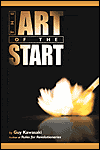 |
||
|
|
Join
The Miami Herald's Business Monday Book Club.
Click here for information.
Music Reviews and Features
Dion Dimucci
Lester Bangs in "Almost Famous"
History of Warner Brothers Music
Dining
Creolina's
Cajun/Creole
'Art
of the Start' serves as toolbox for success.
Guy
Kawasaki's detailed instructions for developing and presenting new ideas
with the goal of bringing them to market.
 The
Art of the Start: The Time-Tested, Battle-Hardened Guide For Anyone Starting
Anything.
Guy Kawasaki.
Portfolio. 216 pages.
The
Art of the Start: The Time-Tested, Battle-Hardened Guide For Anyone Starting
Anything.
Guy Kawasaki.
Portfolio. 216 pages.
BY
RICHARD PACHTER
rpachter@wordsonwords.com
Guy Kawasaki used to be an evangelist for a computer company.
''Evangelist?''
Sure.
He had the unenviable task of persuading developers to write and market
software for Apple's Macintosh computer. In those pre-Windows days, PC
users scoffed at the Mac's graphic interface and mouse, declaring that
this ''toy'' was unworthy of consideration for serious computing.
Though they changed their tune a few years later when PCs (with mice)
ran ''just like Macs,'' Kawasaki's determination and enthusiasm made early
adopters awfully glad they took a chance on that odd, new machine.
Even after he left the company, returned and departed again, Kawasaki
was the personification of intelligently directed tenacity. His efforts
earned fans, not just customers. In that sense, he was, and is, well ahead
the curve.
Reading his latest book I was struck with how much seemed familiar. Then
I realized that many of the newest brainstorms touted by today's hot marketing
gurus were ideas espoused by Kawasaki years earlier.
This new book isn't strictly a marketing guide, but a toolbox with detailed
instructions for developing and presenting new ideas with the goal of
bringing them to market -- eventually
.
The tone is helpful and sympathetic, though Kawasaki's patented ebullience
has been supplanted by a more practical and pragmatic voice. Clearly,
he's suffered through too many inept, overlong and ill-conceived presentations
and pitches, and can now offer sharper advice. But his guidance isn't
limited to just communicating an idea or product; it's more macro than
that.
He writes: ''I use a top-10 list format for all my speeches, and I would
love to begin this book with a top-10 list of the most important things
an entrepreneur must accomplish.'' However, there aren't ten -- there
are only five:
1. Make meaning (inspired by John Doerr). The best reason to start an
organization is to make meaning -- to create a product or service that
makes the world a better place. So your first task is to decide how you
can make meaning.
2. Make a mantra. Forget mission statements; they're long, boring, and
irrelevant. No one can ever remember them -- much less implement them.
Instead, take your meaning and make a mantra out of it. This will set
your entire team on the right course.
3. Get going. Start creating and delivering your product or service. Think
soldering irons, compilers, hammers, saws, and AutoCAD -- whatever tools
you use to build products and services. Don't focus on pitching, writing
and planning.
4. Define your business model. No matter what kind of organization you're
starting, you have to figure out a way to make money. The greatest idea,
technology, product or service is short-lived without a sustainable business
model.
5. Weave a mat (milestones, assumptions and tasks). The final step is
to compile three lists: (a) major milestones you need to meet; (b) assumptions
that are built into your business model; and (c) tasks you need to accomplish
to create an organization. This will enforce discipline and keep your
organization on track when all hell breaks loose -- and all hell will
break loose.''
There are many books on new product development and presentation, but
this one delivers far more than it promises. And there's this: a friend
of mine borrowed my copy while preparing a new business proposal. After
reading about 50 pages, he requested a postponement so he could redo his
pitch. That's as convincing a recommendation as I've ever encountered.
If you'd like to sample Kawasaki's sagacity, check out http://www.artofthestart.com
for a free excerpt.
Like business books? Join the club.